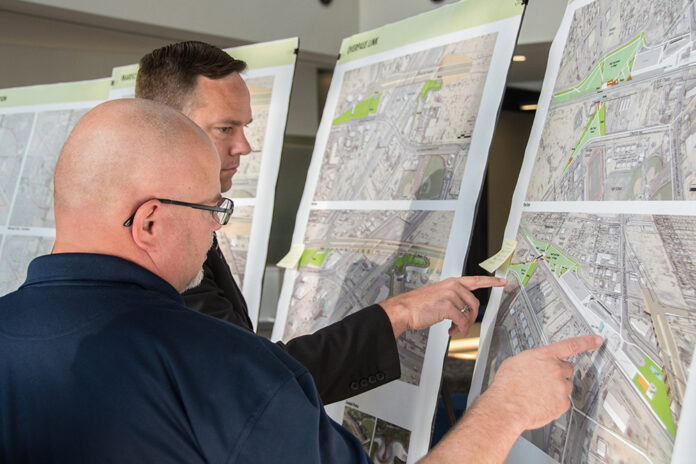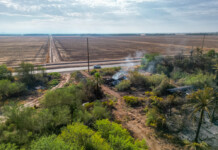
A possible pedestrian bridge spanning the Union Pacific Railroad was discussed on Tuesday during an open house at Maricopa City Hall.
Members of the city’s planning department and contracted architects met members of the public and local officials in the lobby at City Hall to present three ideas for a pedestrian bridge, which the city hopes will help with foot and bicycle traffic trying to traverse the tracks when trains are present.
J2 Engineering and Environmental Design firm has been contracted by the city to help with the project, and was on hand to answer questions about the designs.
“[The proposed designs] each possess their own unique qualities,” J2 senior landscape architect Dean Chambers said. “They do come with a price tag, though.”
The first design, the “Maricopa Circle,” is the most visually stimulating design, including a snake-like suspension bridge that would hang over the current John Wayne Parkway and UPRR intersection with greenspace/plaza areas at either end.
“The broad turns on either side were designed with cyclists in mind,” Chambers said.
The turns, he added, are still not entirely accommodating to cyclists in some areas, however. A longer ramp to fully accommodate bike riders would be cost prohibitive.
“If you’re a skilled rider, then maybe you could make it,” Chambers said. “But most [cyclists] would have to walk their bikes.”
Estimated costs for the Maricopa Circle design are already around $20.9 million.
The second design, the “Maricopa Station,” is another separate structure with a more simply designed “trellis-type” bridge. Its proposed location would be several hundred yards to the west of the overpass, connecting the northwestern portion of the Heritage District with the area around Maricopa High School.
The design is simple and would fully accommodate cyclists, Chambers said. However, it would require the purchase of land on either side of the tracks, bringing the price tag up to around $17.1 million.
The last and cheapest design pitched was dubbed the “Overpass Link.” Its proposed design includes utilizing the sidewalk on the overpass itself and building two small plazas on the western side of the overpass at either end, where there will be ramps and small parks.
The drawback to the Overpass Link, Chambers said, is that cyclists are not allowed to ride in the roadway on the overpass; the agreement with the Arizona Department of Transportation prohibits it. Cyclists will have to walk their bikes on the side walk to cross the overpass.
These designs are tentative, according to city officials, and will be discussed in detail at future city council and planning-and-zoning meetings.

![Maricopa restauranteur makes Food Network connection [Namkeen Dhaba]](https://www.inmaricopa.com/wp-content/uploads/2024/04/439456716_377105198650519_7536248579664805896_n-218x150.jpg)









![Maricopa’s ‘TikTok Rizz Party,’ explained One of several flyers for a "TikTok rizz party" is taped to a door in the Maricopa Business Center along Honeycutt Road on April 23, 2024. [Monica D. Spencer]](https://www.inmaricopa.com/wp-content/uploads/2024/04/spencer-042324-tiktok-rizz-party-flyer-web-218x150.jpg)

![Maricopa restauranteur makes Food Network connection [Namkeen Dhaba]](https://www.inmaricopa.com/wp-content/uploads/2024/04/439456716_377105198650519_7536248579664805896_n-100x70.jpg)


